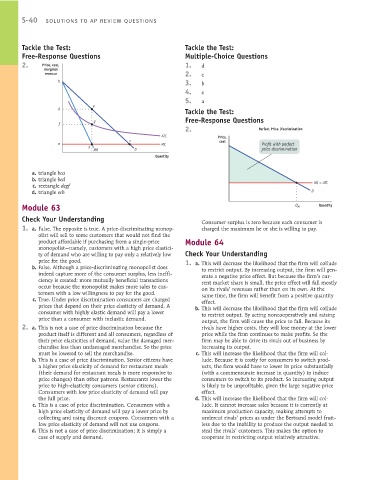Page 886 - Krugmans Economics for AP Text Book_Neat
P. 886
S-40 SOLUTIONS TO AP REVIEW QUESTIONS
Tackle the Test: Tackle the Test:
Free-Response Questions Multiple-Choice Questions
2. Price, cost, 1. d
marginal
revenue 2. c
3. b
b
4. e
5. a
e
Tackle the Test:
d
Free-Response Questions
g
f
2. Perfect Price Discrimination
ATC Price,
c cost
a MC Profit with perfect
h
MR D price discrimination
Quantity
a. triangle bca
b. triangle bed
MC = ATC
c. rectangle degf
d. triangle ech D
Module 63 Q M Quantity
Check Your Understanding
Consumer surplus is zero because each consumer is
1. a. False. The opposite is true. A price-discriminating monop- charged the maximum he or she is willing to pay.
olist will sell to some customers that would not find the
product affordable if purchasing from a single-price Module 64
monopolist—namely, customers with a high price elastici-
ty of demand who are willing to pay only a relatively low Check Your Understanding
price for the good. 1. a. This will decrease the likelihood that the firm will collude
b. False. Although a price-discriminating monopolist does to restrict output. By increasing output, the firm will gen-
indeed capture more of the consumer surplus, less ineffi- erate a negative price effect. But because the firm’s cur-
ciency is created: more mutually beneficial transactions rent market share is small, the price effect will fall mostly
occur because the monopolist makes more sales to cus- on its rivals’ revenues rather than on its own. At the
tomers with a low willingness to pay for the good. same time, the firm will benefit from a positive quantity
c. True. Under price discrimination consumers are charged effect.
prices that depend on their price elasticity of demand. A b. This will decrease the likelihood that the firm will collude
consumer with highly elastic demand will pay a lower to restrict output. By acting noncooperatively and raising
price than a consumer with inelastic demand.
output, the firm will cause the price to fall. Because its
2. a. This is not a case of price discrimination because the rivals have higher costs, they will lose money at the lower
product itself is different and all consumers, regardless of price while the firm continues to make profits. So the
their price elasticities of demand, value the damaged mer- firm may be able to drive its rivals out of business by
chandise less than undamaged merchandise. So the price increasing its output.
must be lowered to sell the merchandise. c. This will increase the likelihood that the firm will col-
b. This is a case of price discrimination. Senior citizens have lude. Because it is costly for consumers to switch prod-
a higher price elasticity of demand for restaurant meals ucts, the firm would have to lower its price substantially
(their demand for restaurant meals is more responsive to (with a commensurate increase in quantity) to induce
price changes) than other patrons. Restaurants lower the consumers to switch to its product. So increasing output
price to high-elasticity consumers (senior citizens). is likely to be unprofitable, given the large negative price
Consumers with low price elasticity of demand will pay effect.
the full price. d. This will increase the likelihood that the firm will col-
c. This is a case of price discrimination. Consumers with a lude. It cannot increase sales because it is currently at
high price elasticity of demand will pay a lower price by maximum production capacity, making attempts to
collecting and using discount coupons. Consumers with a undercut rivals’ prices as under the Bertrand model fruit-
low price elasticity of demand will not use coupons. less due to the inability to produce the output needed to
d. This is not a case of price discrimination; it is simply a steal the rivals’ customers. This makes the option to
case of supply and demand. cooperate in restricting output relatively attractive.

